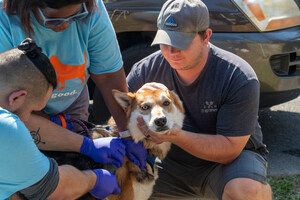VANCOUVER, Wash., May 30, 2018 /PRNewswire/ -- Banfield Pet Hospital® today released its 2018 State of Pet Health® Report, which explores the science behind skin allergies in pets and sheds light on flea, environmental and food allergies.
With food allergies in humans being reported at an all-time high, veterinarians are seeing pet owners become increasingly concerned about food allergies in their pets. However, according to the report, food allergies affect just 0.2 percent of dogs and 0.1 percent of cats, meaning other causes should be explored if food allergies are suspected. In fact, pets can be allergic to fleas, and this allergy has been on the rise over the past 10 years, including a 12 percent increase in dogs and a 67 percent increase in cats. Environmental allergies are also on an upward trend, with a more than 30 percent increase in dogs and 11 percent increase in cats over the last decade.
"At Banfield, we're deeply invested in partnering with our clients to help keep pets happy and comfortable – and that includes getting to the bottom of signs to uncover accurate diagnoses," said Dr. Daniel Aja, Senior Vice President and Chief Medical Officer at Banfield Pet Hospital. "With thousands of itchy pets coming through our doors each year, Banfield's 2018 State of Pet Health Report aims to uncover the common causes and offer pet owners the tools they need to help their pets find relief."
Key findings from Banfield's 2018 State of Pet Health Report include:
- Flea Allergies. Fleas are the most common external parasite Banfield sees on its patients. According to Banfield data, cats are twice as likely as dogs to be found with fleas; however, fleas exist in all types of weather, on outdoor and indoor pets and in all 50 states – all year long. Therefore, year-round prevention with veterinarian-approved medication is key.
- Environmental Allergies. Although environmental allergens for pets vary by region and climate, many are found in a typical pet owner's home – including pollen, dander, molds and cleaning solutions. Additionally, Wisdom Health research has found additional evidence that links genetics to the development of environmental allergies in dogs. Some commonly affected breeds include: Golden Retrievers, Labrador Retrievers, German Shepherds, Cocker Spaniels, Boxers, French Bulldogs and West Highland White Terriers.1
- Food Allergies. Thirty percent of food-allergic dogs and cats are found to have another allergic skin condition. 2 Food allergic pets are also more prone to skin infections - dogs are six times more likely to develop a bacterial skin infection, whereas cats are 15 times more likely.
The largest of its kind, the 2018 State of Pet Health Report captures medical data from the more than three million dogs and cats Banfield cared for in 2017. To learn more about dermatological trends and skin allergies in pets, visit www.StateofPetHealth.com/allergies.
About Banfield Pet Hospital®
Founded in Portland, Ore. in 1955, Banfield is the largest general-veterinary practice in the world. In 2007, Banfield joined the Mars, Inc. family of businesses, and today has more than 1,000 hospitals across the United States and Puerto Rico. More than 3,500 Banfield veterinarians are committed to providing high-quality veterinary care for over three million pets annually. In 2017, Banfield Pet Hospital – including the work of the Banfield Foundation – was named among Points of Light's 'Civic 50' as one of the most community-minded companies in the U.S. Press seeking additional information are invited to call the Media Hotline: (888) 355-0595.
1 Merck Veterinary Manual, 2018. https://www.merckvetmanual.com/integumentary-system/atopic-dermatitis/canine-atopic-dermatitis. Accessed April 2018.
2 Verlinden A, Hesta M, Millet S, and Janssens GPJ. 2006. Food allergy in dogs and cats: a review. Critical Reviews in Food Science and Nutrition 46(3): 259-73.
SOURCE Banfield Pet Hospital
WANT YOUR COMPANY'S NEWS FEATURED ON PRNEWSWIRE.COM?
Newsrooms &
Influencers
Digital Media
Outlets
Journalists
Opted In






Share this article